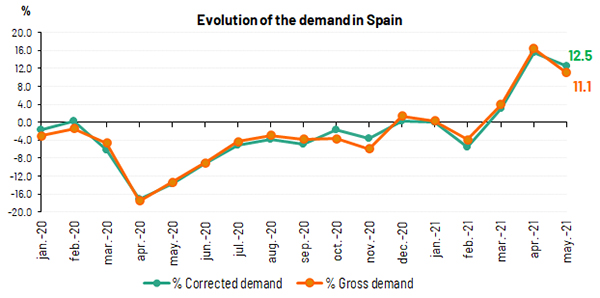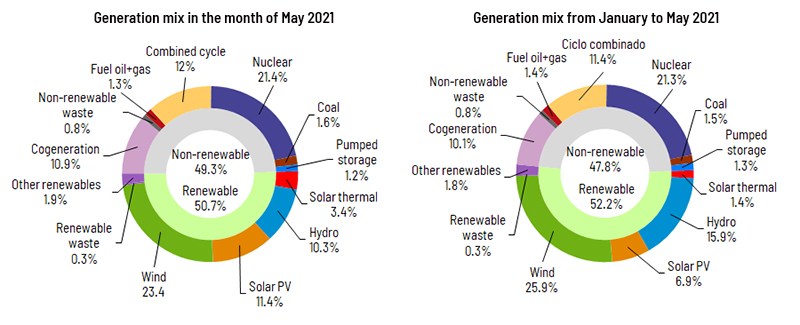Discover what Red Eléctrica is, what we do, and why we are the backbone of the electricity system in Spain and the ecological transition.
Demand for electricity in Spain increased 11.1% in May
- 50.7% of monthly generation came from renewable sources and 73.3% was produced from technologies that do not emit CO2 equivalent emissions.
- Wind power, responsible for 23.4% of the electricity produced in May, was the leading technology this month, while photovoltaic solar power set a new record for monthly production, with 2,331 GWh.
- Electricity demand grew by 16% in the Balearic Islands and 11.8% in the Canary Islands compared to May 2020.
National electricity demand in May is estimated at 20,338 GWh, a value that is 11.1% higher than the figure recorded in the same month last year. After having factored in the influence of seasonal and working patterns, the figure is 12.5% higher than in May last year.

Compared to a pre-pandemic period (May 2019) and after having factored in the influence of seasonal and working patterns, national electricity demand has fallen 3%.
In the first five months of 2021, demand is estimated at 106,033 GWh, a figure that is 4.9% more than in 2020. Once again, after having factored in the influence of seasonal and working patterns, demand is 4.5% higher than in the same period last year.
During the month of May, and according to data estimated at the time of this press release, generation coming from renewable energy sources represented 50.7% of the generation mix nationwide. During the month, 10% more green energy (in GWh) was produced than in the same period in 2020.
With the information available at the time of this press release, wind energy generation in May reached 4,794 GWh, 20.9% higher than in the same month last year, and accounted for 23.4% of production nationwide, making it the leading technology in the national generation mix, ahead of nuclear (21.4%) and combined cycle (12%).
During this month, solar photovoltaic generated 2,331 GWh, 42.4% more than in May 2020. With a share of 11.4 % of the generation mix, this is the highest amount of electricity generated in one month since records began at a national level (2007). According to provisional data available at the time of this press release, 29 May saw the maximum daily level of solar photovoltaic generation (89 GWh) and the highest share of this technology in the generation mix, representing 14.7% of the day's total.
For its part, Solar thermal generation, responsible for 3.4% of the monthly total, grew by 25.4% reaching 693 GWh.
As a result, 73.3% of the electricity generated in May was obtained using technologies which produce zero CO2 equivalent emissions.

Demand for electrical energy in the peninsular electricity system grew 11%
Demand for electrical energy in the peninsular electricity system in May is estimated at 19,276 GWh, a value that is 11% higher than that recorded in May 2020. After having factored in the influence of seasonal and working patterns, the demand for electricity is 12.5% up on that registered in the same month last year.
Compared to a pre-pandemic period (May 2019) and after having factored in the influence of seasonal and working patterns, electricity demand on the peninsula has fallen 2.4%.
From January to May 2021, electricity demand on the Spanish mainland is estimated at 100,744 GWh, a value that is 5.2% higher than in 2020. In this case, after having factored in the influence of seasonal and working patterns, demand is 4.8% higher than that recorded in the same period last year.
During May, and according to data estimated at the time of this press release, 52% of peninsular generation came from renewable energy sources and 75.7% was obtained using technologies which produce zero CO2 equivalent emissions. For its part, wind energy stood at 4,625 GWh, 18.7% higher than in May last year, and was the leading technology accounting for a share of 23.7% of the total generation mix on the Spanish mainland.
Demand for electricity in May increases 16% in the Balearic Islands and 11.8% in the Canary Islands
In the Balearic Islands, the demand for electricity in May is estimated at 379,639 MWh, a value that is 16% higher than that recorded in May 2020. After factoring in the influence of seasonal and working patterns, the figure is 19.1% up on that recorded in May 2020.
Compared to a pre-pandemic period (May 2019) and after having factored in the influence of seasonal and working patterns, electricity demand on the Balearic Islands has fallen 19.6%.
In the first five months of 2021, electricity demand in the Balearic Islands is estimated in gross terms at 2,000,766 MWh, 4.6% more than in the same period in 2020.
Combined cycle, with 78.5% of the total production in the Balearic Islands, was the leading source of electricity generation in May, a month in which renewable technologies and those which produce zero CO2 equivalent emissions accounted for 9% of the total generation mix in the archipelago.
Furthermore, during the month, energy transferred via the Spanish Peninsula-Balearic Islands submarine link contributed to covering 29.4% of the electricity demand in the Balearic Islands.
Regarding the Canary Islands, electricity demand is estimated at 649,636 MWh, 11.8% higher than that recorded in May last year. After factoring in the influence of seasonal and working patterns, the figure is 11.5% higher than that registered in the same month last year.
Compared to a pre-pandemic period (May 2019) and after having factored in the influence of seasonal and working patterns, the demand for electricity in the Canary Islands has fallen 10.2%.
In the first five months of 2021, electricity demand in the Canary Islands is estimated in gross terms at 3,126,948 MWh, 4.5% less than in the same period last year.
In the Canary Islands, although combined cycle was the leading source of electricity generation in May with a share of 37.4%, renewables and those which produce zero CO2 equivalent emissions accounted for 30.6% of the total generation mix, the highest share since records began (2007). In fact, during six days of the month, more than 40% of total generation was ‘green’.
Consult our Daily Balance Report for more information on the National, Peninsular, Balearic Islands and Canary Islands electricity systems as at the close of May.











